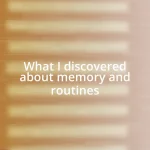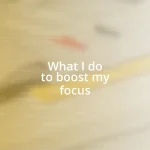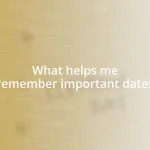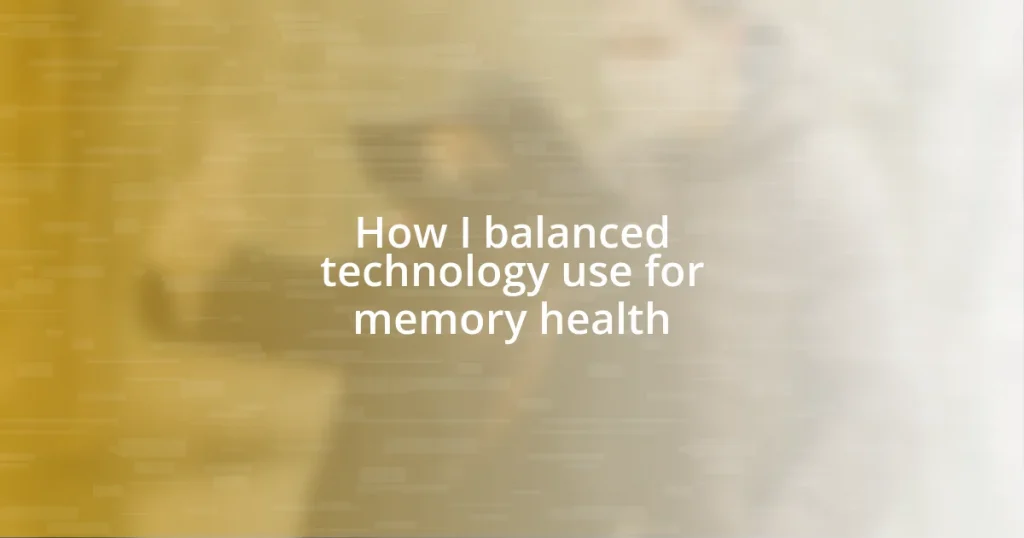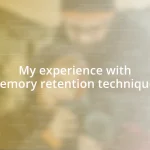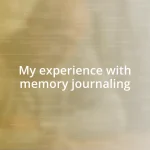Key takeaways:
- Finding a balance in technology use is essential for memory health, as excessive screen time can lead to mental fatigue and distraction.
- Incorporating mindfulness and self-awareness regarding technology interactions can significantly enhance focus, memory retention, and overall well-being.
- Engaging in offline activities and creating a structured technology plan can improve mental clarity, enrich experiences, and foster social connections while using memory-enhancement apps.

Understanding the impact of technology
Technology is a double-edged sword. On one hand, it can enhance our memory by providing tools for organization and quick access to information, which I personally found beneficial during college when juggling multiple subjects. However, on the flip side, I’ve noticed that excessive screen time often left me feeling mentally drained. Have you felt that sense of overwhelm too?
From my experience, the constant notifications and information overload can create a scattered mind. Once, I decided to take a digital detox for a weekend, and I was amazed at how much clearer my thoughts became. It’s funny how stepping away from our devices can help us reconnect with ourselves, isn’t it?
While technology offers innovative ways to support our memory, like apps for reminders and notes, I believe we need to exercise caution. Finding a balance is crucial. After all, how often do we use our devices to escape from reality rather than to engage with it? Reflecting on this has changed how I interact with technology, leading me to be more mindful about when and how I use it.

Recognizing memory health needs
Recognizing the needs of our memory health can be challenging, especially in a world saturated with technology. I remember when I first started using various apps to help me remember appointments and tasks. While they seemed helpful initially, I soon realized that relying solely on technology left gaps in my memory recall, making it hard to remember things without my devices. Have you ever felt like you were losing track of what really mattered due to over-dependence on gadgets?
As I delved deeper into this topic, I learned that our memory needs not only involve external tools but also self-awareness and mental space. I had a moment of clarity during a stroll in the park without my phone. Without the usual distractions, I started to engage my mind more actively, recalling details I often overlooked. This experience led me to understand how vital it is to create environments that nurture memory, distinct from the constant pull of digital devices.
I’ve also discovered that tuning into my feelings and noticing when my mind feels cluttered can directly influence my memory health. For example, when I recognized I was stressed or overwhelmed, I’d take a short break away from screens, which often resulted in better focus when I returned. Listening to how my mind felt truly revolutionized my approach—have you noticed how modern life can leave your thoughts racing?
| Key Aspects | Impact on Memory Health |
|---|---|
| Mindfulness | Enhances focus and memory retention |
| Digital Detox | Improves clarity and reduces mental fatigue |
| Self-awareness | Allows recognition of memory lapses |

Setting technology usage limits
Setting limits on technology use is essential for maintaining a healthy memory. Personally, I began to notice a significant difference in my mental clarity when I implemented specific usage boundaries. For instance, I decided to restrict my screen time in the evenings. This small change allowed me to unwind without the constant pressure of notifications, which I had unknowingly allowed to dictate my time. Have you ever considered how establishing boundaries can alter your relationship with technology?
To support better memory health, here are some practical limits I found helpful:
- Designate tech-free hours: Setting aside specific times for family or relaxation without screens can enhance connection and mindfulness.
- Track usage: Using apps to monitor how much time I spend on different devices has made me more aware of my habits.
- Prioritize quality over quantity: I chose to engage with fewer, high-quality apps or devices that truly enhance my memory, rather than getting lost in the digital noise.
- Take breaks: Implementing short breaks during tech use has allowed my mind to recharge, reducing the feeling of overwhelm.
- Create device-free zones: Establishing places in my home that are free from technology has helped me engage in more meaningful, distraction-free activities.
These limits not only foster better memory but also allow for deeper connections with the world around me. How about you? Have you thought about the differences that intentional limits could make in your own life?

Incorporating mindful technology practices
Incorporating mindfulness into my technology practices transformed how I interacted with my devices. For instance, I started to pay close attention to my feelings before and after using my phone. I remember feeling anxious scrolling through social media, so I began setting a timer for just 15 minutes a day. What a relief it was to notice my mood lighten after stepping away from mindless scrolling! Have you tried paying attention to how your devices make you feel?
I also found that starting my day with a focused intention helped steer my tech use in a positive direction. Instead of diving into emails or social media first thing in the morning, I now take a few moments for mindfulness, which prepares my mind for the day ahead. This shift allowed me to approach my technology use with purpose rather than reflex, resulting in clearer thoughts and better retention of what I encountered. Have you ever wondered how your morning habits influence your mental clarity throughout the day?
Engaging in mindful practices isn’t just about reducing time on devices; it’s about enhancing the quality of the time I do spend. I’ve adopted the habit of reflecting on my digital interactions—asking myself whether they contribute to my memory health or lead to distractions. After implementing this self-check, I realized that many apps I scrolled through had little to offer. Instead, I leaned into tech that truly enriched my life, such as memory games that challenged my brain. Have you considered questioning the value of your digital interactions? It’s a game-changer!

Using apps for memory improvement
Using memory-enhancement apps has been a game-changer for me. I initially tried various apps with high hopes but quickly felt overwhelmed by too many options. However, finding a few that truly resonated with me—like Lumosity and Elevate—changed everything. Have you ever felt that rush when you tackle a challenging brain game and actually improve? It’s incredibly satisfying!
One day, after seeing significant progress on Lumosity’s cognitive tasks, I realized that not only was my memory sharpening, but my mood also seemed to brighten. You know how electronic glitches can be frustrating? Well, these apps made the challenge enjoyable. A simple reward system keeps me disciplined and motivated. I’ve made it a point to mix fun memory games with more serious learning modules. Balancing enjoyment with brain training has become my secret recipe for success. What kind of activities make you feel engaged and energized?
I also began inviting friends to join me in these digital memory challenges. Competing against each other not only spiked our engagement but brought a fun, social element to the entire process. Sometimes, we’d send screenshots of our scores, igniting a bit of friendly rivalry. This shared experience has transformed what could be a solitary task into a vibrant social activity. Have you considered leveraging your friendships to elevate your tech experiences? When you combine memory apps with social connections, it creates a sense of community along the path to better memory health.

Engaging in offline activities
Engaging in offline activities has become an essential part of my routine. I discovered the beauty of simple pleasures like gardening, which not only draws me outdoors but also grants me a sense of accomplishment as I watch the plants flourish. Have you ever experienced that soothing calmness from getting your hands in the soil? There’s something about stepping away from screens and reconnecting with nature that revitalizes my mind.
I also found joy in old-school hobbies, like reading physical books. I must admit, curling up with a good novel allows my imagination to soar in ways scrolling through a screen never could. Each time I turn the pages, I relish the depth of the story unfolding, and I notice that my retention improves because there’s no distraction of notifications. Does reading take you to distant worlds, or do you prefer other forms of immersive offline experiences?
Lately, I’ve taken up learning to paint, and it has been incredibly therapeutic. With each brushstroke, I feel more present and engaged in the moment. It’s fascinating how an hour of creativity can wash away the clutter of daily worries and help me focus better. Have you ever tried channeling your thoughts into an artistic outlet? I genuinely believe that these offline endeavors not only enrich my life but also enhance my memory by keeping my mind active and my spirit high.

Creating a balanced technology plan
Creating a balanced technology plan isn’t just about limiting screen time; it’s about making intentional choices that enrich my digital experience. I decided to set specific time slots for using memory apps. For example, I allocate 30 minutes in the morning and another 30 minutes in the evening for these activities. By doing this, I found that my brain feels more energized instead of drained, allowing me to enjoy technology without guilt or overwhelm. Have you ever established boundaries with your tech use? It can genuinely change the game.
In addition to scheduled app time, I prioritize a variety of activities that work for me. I curate a mix of brain training, educational podcasts, and even online discussions around memory health. This diversity prevents boredom and keeps my mind engaged. For instance, I recently joined an online book club where we discussed memory-enhancing techniques, intertwining technology with real-life applications. How can you incorporate diverse elements into your tech plan? I believe that blending different formats not only sharpens memory but enhances overall learning enjoyment.
Finally, reflecting on my technology use has become a vital practice. I keep a weekly journal of my experiences, noting what worked and what didn’t. This allows me to make tweaks to my plan based on my emotional and cognitive responses. Honestly, there are days when scrolling mindlessly feels empowering. Yet, others remind me to engage mindfully with the tools at hand. Have you ever noticed how your feelings change when interacting with technology? It’s enlightening to see how I can adjust my approach based on my needs and moods, reinforcing the balance I strive for in my tech-driven life.



